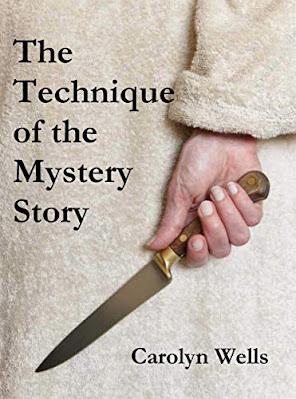by Carolyn Wells
(eText)
AUTHOR OF "THE CLUE," "A CHAIN OF EVIDENCE," "THE MAXWELL MYSTERY," ETC.
TABLE OF CONTENTS:
CHAPTER I—THE ETERNAL CURIOUS
1. The Inquisition into the Curious is Universal
2. Early Riddles
3. The Passion for Solving Mysteries
CHAPTER II—THE LITERATURE OF MYSTERY
1. The Rightful Place of the Mystery Story in Fiction
2. The Mystery Story Considered as Art
3. The Claims of Antagonists and Protagonists
CHAPTER III—THE HISTORY OF MYSTERY
1. Ancient Mystery Tales
CHAPTER IV—GHOST STORIES
1. A Working Classification
2. The Ghost Story
3. Famous Ghost Stories
4. The Humorous Ghost Story
CHAPTER V—RIDDLE STORIES
1. Some Notable Riddle Stories
2. The Nature of the Riddle Story and Its Types
CHAPTER VI—DETECTIVE STORIES
1. What Is a Detective Story
2. Rise of the Detective Story
3. The Detective—Fictive and Real
4. Fiction versus Fact
5. The Interest of the Detective Story
6. A Summing Up
CHAPTER VII—THE DETECTIVE
1. The Real Detective and His Work
2. Fictive Detective Material
3. The Transcendent Detective
4. Pioneer Detectives of Fiction
5. Recent Detectives of Fiction
6. The Scientific Detective of Fiction
7. The New Psychology in Detective Stories
8. Other Types
CHAPTER VIII—DEDUCTION
1. Ratiocination in Early Detective Stories
2. Deduction Used in Every-day Life
3. The Analytical Element in the Detective Story
4. Poe's Detective—The Prototype
5. The Detective in the Novel
CHAPTER IX—APPLIED PRINCIPLES
1. The Detectives of Poe, Doyle, and Gaboriau
2. Individuality of these Detectives
3. The Real Sherlock Holmes
CHAPTER X—THE RATIONALE OF RATIOCINATION
1. Sherlock Holmes' Method
2. Lecoq's Method
3. Other Methods
4. Holmes' Method Evaluated
5. The Inductive and the Deductive Methods
6. Two Striking Examples
CHAPTER XI—CLOSE OBSERVATION
1. The Search for Clues
2. The Bizarre in Crime
3. The Value of the Trivial
4. The Tricks of Imitation
CHAPTER XII—OTHER DETECTIVES OF FICTION
1. Some Original Traits
2. Two Unique Detectives
CHAPTER XIII—PORTRAITS
1. Some Early Detective Portraits
2. Some More Modern Portraits
3. Some Less Known Portraits
4. Idiosyncrasies of Fictional Detectives
5. Favorite Phrases of Detectives
CHAPTER XIV—DEVIOUS DEVICES
1. Snow and Rain
2. Some Particularly Hackneyed Devices
3. Devices Which Are Not Plausible
CHAPTER XV—FOOTPRINTS AND FINGERPRINTS
1. The Omnipresence of Footprints
2. Other Miraculous Discoveries
3. Remarkable Deductions from Footprints
4. Fingerprints and Teeth-marks
CHAPTER XVI—MORE DEVICES
1. Tabulated Clues
2. Worn-out Devices
3. The Use of Disguise
4. Other "Properties"
CHAPTER XVII—FAKE DEVICES
1. The "Trace" Fallacy
2. The Destruction of Evidence
3. False Hypotheses
4. Errors of Fact and of Inference
5. The Use of Illustrative Plans
6. The Locked and Barred Room
CHAPTER XV—MURDER IN GENERAL
1. Murder Considered in the Abstract
2. Murder as a Fine Art
3. The Murder Theme
4. The Robbery Theme
5. The Mysterious Disappearance
CHAPTER XIX—PERSONS IN THE STORY
1. The Victim
2. The Criminal
3. Faulty Portrayal of the Criminal
4. The Secondary Detective
5. The Suspects
6. The Heroine and the Element of Romance
7. The Police 8. The Supernumeraries
CHAPTER XX—THE HANDLING OF THE CRIME
CHAPTER XXI—THE MOTIVE
CHAPTER XXII—EVIDENCE
1. The Coroner
2. The Inquest
3. The Witnesses
4. Presentation of the Evidence
5. Circumstantial Evidence
6. Deductions from Evidence
7. Deductions from Clues
8. Evidence by Applied Psychology
9. Direct Observation
10. Exactness of Detail
11. Theories of Evidence
CHAPTER XXIII—STRUCTURE
1. Length
2. The Short-Story and the Novel
3. Singleness of Plot in the Detective Story
4. The Question of Length
5. The Narrator in the Detective Story
6. The Setting
CHAPTER XXIV—PLOTS
1. The Plot is the Story
2. Constructing the Plot
3. Maintaining Suspense
4. Planning the Story
5. The Question of Humor
6. Some Unique Devices
CHAPTER XXV—FURTHER ADVICES
1. The Use of Coincidences
2. The Use of Melodrama
3. Dullness
4. Unique Plots and their Solubility
5. Women as Writers of Detective Stories
CHAPTER XXVI—FINAL ADVICES
1. General Qualities of the Detective Story
2. Correctness
3. Names
4. Titles
The PDF might take a minute to load. Or, click to download PDF.
If your Web browser is not configured to display PDF files. No worries, just click here to download the PDF file.



No comments:
Post a Comment